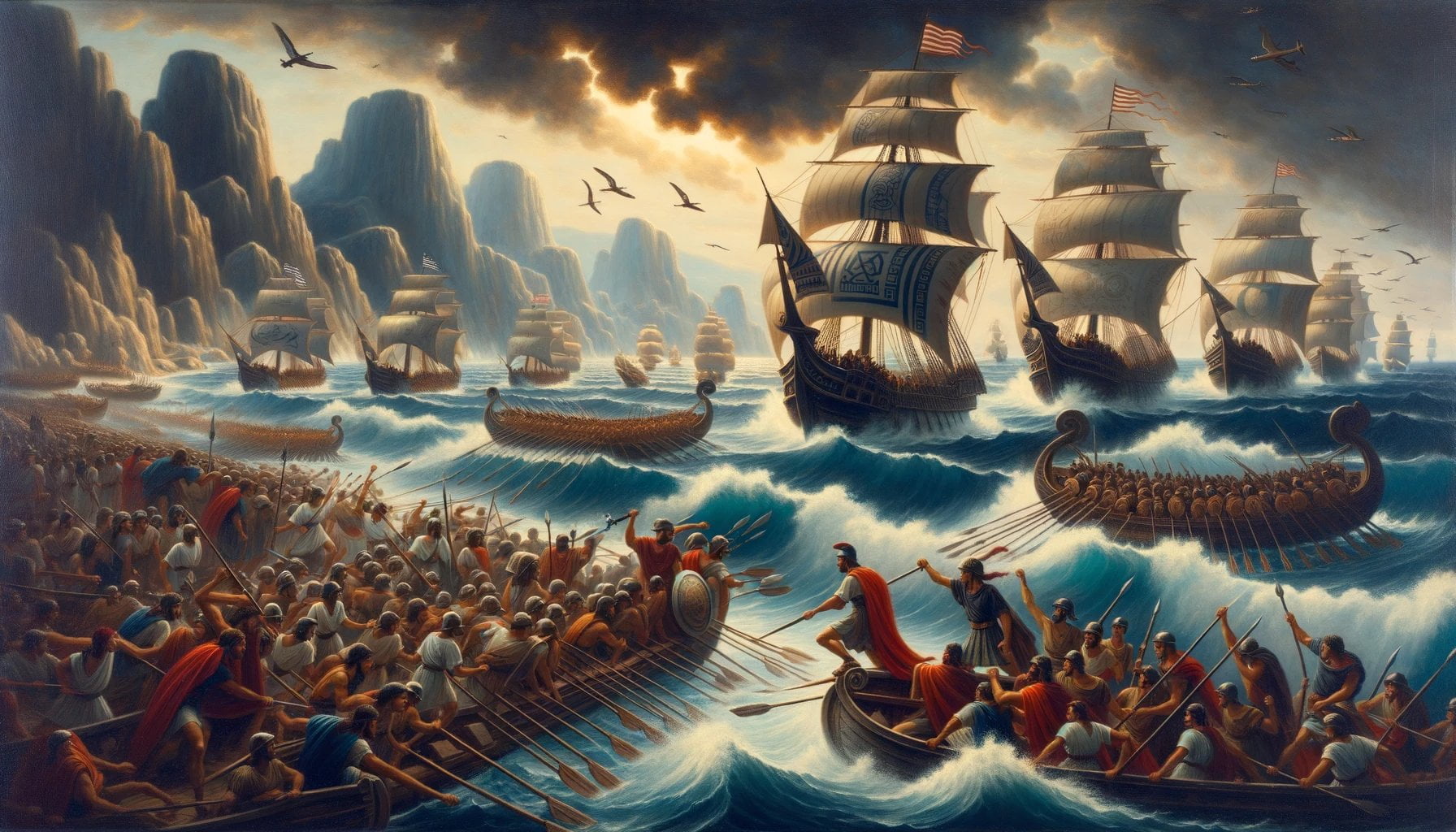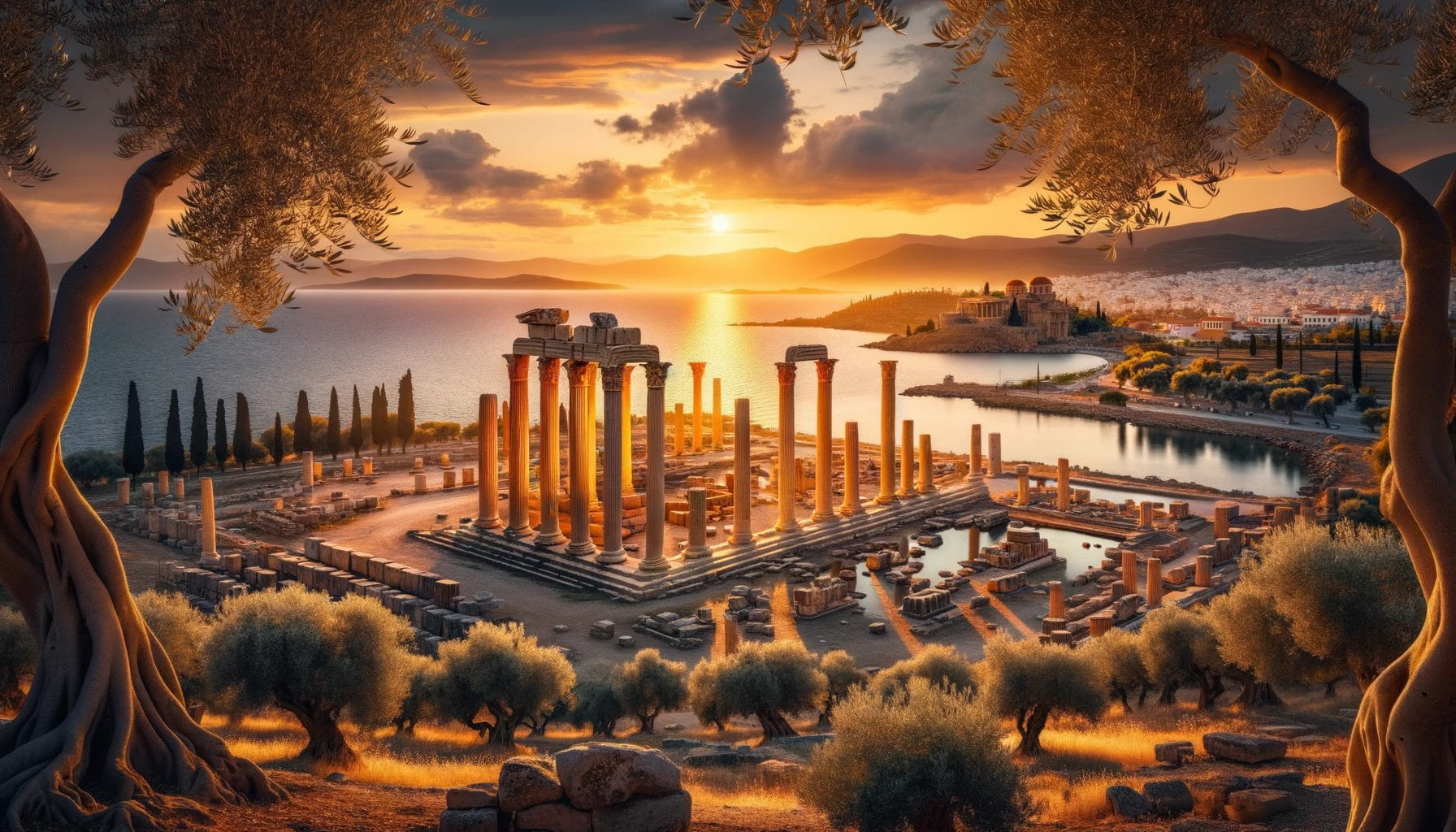Embark on a captivating journey to the ancient Greece of Salamis as we unveil its hidden treasures and unravel the mysteries of this remarkable city-state. Through meticulous excavation, thorough research, and a passion for history, we delve into the depths of Salamis to bring you an immersive exploration of its cultural significance, political dynamics, and economic achievements. Join us as we unearth Salamis, a mesmerizing window into the vibrant world of ancient Greece.

Key Takeaways:
- Salamis is an island located west of Athens in Greece’s Saronic Gulf.
- The Battle of Salamis, fought in 480 BC, was a crucial naval battle between an alliance of Greek city-states, led by Themistocles, and the Persian Empire under King Xerxes. The Greek fleet achieved a decisive victory, halting the Persian advance into Greece.
- The battle showcased the strategic brilliance of Themistocles and the courage of the Greek warriors.
- Salamis is historically and culturally significant, being the birthplace of Ajax, a figure from Greek mythology, and the famous playwright Euripides.
- Euripides’ birth is associated with the day of the Battle of Salamis.
- Additional information about Salamis and the Battle of Salamis can be found in the provided sources, including Encyclopedia.com and Wikipedia.
Unearthing Salamis: Exploring the Ancient Greece of Salamis
In the vast tapestry of ancient Greek civilizations, one city-state stands out for its remarkable history and achievements – Salamis. Situated in the picturesque Saronic Gulf, west of Athens, Salamis captivates the imagination with its rich cultural heritage and its pivotal role in shaping the events of ancient Greece.
The Legendary Battle of Salamis
At the heart of Salamis’ legacy lies the momentous Battle of Salamis, an epic naval confrontation that unfolded in 480 BC. Led by the ingenious strategist Themistocles, the united forces of Greek city-states clashed against the mighty Persian Empire, commanded by King Xerxes. Despite being heavily outnumbered, the Greeks displayed unparalleled courage and tactical brilliance, securing a resounding victory.
The Battle of Salamis marks a turning point in the Greco-Persian Wars, effectively halting the Persian advance into Greece and forcing their eventual retreat. The triumph reverberated throughout the ancient world, solidifying the Greeks’ resolve to defend their freedom against imperial ambitions. This legendary clash exemplifies the indomitable spirit and resilience of ancient Greek warriors.
Salamis: Birthplace of Legends
Beyond its military significance, Salamis reverberates with mythological and cultural symbolism. It proudly claims to be the birthplace of Ajax, the mighty hero of Greek legend, renowned for his valor and strength. Additionally, Salamis holds a deep connection to the celebrated playwright Euripides, with his birth coinciding with the fateful day of the Battle of Salamis. The island’s mystique intertwines with the fabric of ancient Greek mythology, providing a captivating backdrop to the unfolding drama of history.
Unlocking the Secrets of Salamis
To truly fathom the allure of Salamis and the intricacies of ancient Greek civilization, one must delve into the enigmatic realms of archaeology and historical research. Abundant artifacts and remnants from this bygone era paint a vivid portrait of Salamis’ esteemed past. By meticulously examining these relics and deciphering historical documents, archaeologists and historians unveil a profound understanding of the city-state’s cultural significance, political dynamics, and economic prowess.
With each fragment of pottery, inscription, or architectural marvel unearthed, the mysterious whispers of Salamis find voice, allowing us to unlock the secrets of its ancient civilization. These clues, meticulously analyzed, weave together a compelling narrative that breathes life into the stories, triumphs, and struggles of the people who walked its ancient streets.
Traversing Time and Space
As an archaeologist and historian dedicated to the study of ancient Greek civilizations, I am passionate about bridging the gap between the past and the present. Through my extensive research, fieldwork, and academic background, I invite you to travel back in time and immerse yourself in the wonders of Salamis.
Together, let us embark on a captivating journey, unearthing the mysteries of Salamis and unraveling the tapestry of ancient Greece. By exploring the archaeological sites, peering into historical texts, and embracing the stories of its inhabitants, we can shed light on a bygone era and appreciate the profound impact that Salamis had on the ancient world.
Please note that the provided summary is generated using AI and the original source information can be accessed through the provided links.
In ancient Greece, the region of Laconia was renowned for its Spartan warriors and rich history. Discover more about Laconia in ancient Greece by clicking here.
Explore the fascinating connection between ancient Greece and the Black Sea region. Dive into the depths of this historical link here.
Curious about the remarkable achievements of ancient Greece? Uncover the wonders of this ancient civilization by clicking here.
Delve into the captivating history of Rhodes in ancient Greece. Unearth the mysteries and stories of this remarkable island by clicking here.
Immerse yourself in the world of ancient Greece and its rulers. Uncover the power and influence of these historical figures by clicking here.
Economic and Trade Relations of Salamis in Ancient Greece
Key Takeaways:
– Salamis, an island, town, and municipality in eastern Greece, played a significant role in ancient Greek economic and trade relations.
– The Battle of Salamis, a major naval victory for the Greek city-states led by Themistocles over the Persian Empire, demonstrated the strategic importance of Salamis and its impact on trade in the region.
– Salamis served as a vital trading hub, connecting Greece with other Mediterranean civilizations and facilitating the exchange of goods, resources, and ideas.
– The island’s strategic location allowed it to develop extensive maritime trade networks, boosting its economic prosperity and influence in the ancient world.
– Salamis was renowned for its shipbuilding industry, producing high-quality vessels that were in high demand for trade and warfare.
– The island’s diverse economy included agriculture, fishing, pottery production, and mining, contributing to its wealth and economic stability.
Salamis Island, located in the Saronikós Gulf of the Aegean Sea, was not only known for the decisive Battle of Salamis but also for its significant contributions to ancient Greek economic and trade relations. The island’s strategic location and rich resources made it a thriving center of commerce and a crucial hub in the eastern Mediterranean.
Salamis played a pivotal role in the Battle of Salamis in 480 BC, where the Greek fleet led by Themistocles confronted and defeated the Persian naval forces. This victory not only halted the Persian Empire’s advance into Greece but also showcased the island’s strategic importance in securing trade routes and maintaining Greek sovereignty.
As a bustling trading center, Salamis connected Greece with other Mediterranean civilizations, facilitating the exchange of goods, resources, and ideas. Its location at the crossroads of trade routes allowed for extensive commercial activities and the establishment of prosperous maritime networks. Traders from various regions flocked to Salamis, enriching the island’s economy and cultural diversity.
The island’s shipbuilding industry was particularly renowned, with Salamis producing high-quality vessels that were in high demand. These ships served both commercial and military purposes, reinforcing the island’s maritime dominance and contributing to its economic prosperity. The superior craftsmanship of Salamis’s ships made them a valuable asset in trade and warfare, enhancing its status as a key player in the ancient Greek world.
Salamis boasted a diverse economy, supported by agriculture, fishing, pottery production, and mining. Its fertile soil allowed for successful cultivation of crops, while the surrounding waters provided ample fishing opportunities. The island’s potters crafted exquisite pottery, which served as both practical items and luxury goods traded throughout the Mediterranean.
Furthermore, Salamis’s rich mineral resources, such as copper and silver, fueled its economic growth and prosperity. The island’s mines supplied valuable metals that were highly sought after in the ancient world, further boosting Salamis’s economic power and influence.
In conclusion, Salamis’s economic and trade relations in ancient Greece were integral to its success and status as a foremost city-state. Its strategic location, shipbuilding industry, and diverse economy made it a hub of commerce and a key player in Mediterranean trade networks. The island’s contributions to ancient Greek history and its lasting economic impact cannot be understated.
Sources:
– Britannica: Salamis Island
– Wikipedia: Battle of Salamis
Cultural and Artistic Contributions of Salamis
Salamis, an ancient city-state in Greece, holds a captivating history with deep cultural and artistic contributions that shaped the region during the ancient era. From its strategic location to its significant battles, Salamis played a pivotal role in Greek civilization. Let’s explore the cultural and artistic marvels that emerged from this ancient city.
The Birthplace of Heroes and Playwrights
Salamis is renowned as the birthplace of numerous historical figures and renowned playwrights. One such hero is Ajax, a prominent character in Greek mythology known for his strength and bravery. Salamis also has a deep connection to the celebrated playwright Euripides, whose tragic plays captivated audiences across Greece.
Architectural Splendors
Salamis boasts a wealth of architectural treasures that showcase the artistic prowess of its ancient inhabitants. Among notable examples are the Sanctuary of Artemis, a grand temple dedicated to the goddess of the hunt, and the Theater of Salamis, which saw countless dramatic performances and provided a gathering place for the community.
Pottery and Sculpture
The creativity of Salamis extended to the fields of pottery and sculpture. Talented artisans crafted exquisite pottery adorned with intricate designs that depicted scenes from mythology and everyday life. These exquisite vessels served both functional and artistic purposes, reflecting the cultural richness of Salamis. Similarly, sculptors in Salamis produced captivating sculptures, capturing the beauty and essence of the human form.
Influences on Literature and Philosophy
Salamis’s cultural and artistic contributions also permeated into the realms of literature and philosophy. The works of renowned scholars and philosophers from Salamis, such as Solon and Pericles, shaped intellectual discourse and contributed to the development of Greek literature and philosophy. These thinkers inspired generations with their profound insights and philosophical ponderings.
Key Takeaways:
- Salamis, an ancient city-state in Greece, holds significant cultural and artistic contributions.
- It is the birthplace of heroes like Ajax and renowned playwrights like Euripides.
- Salamis showcases splendid architectural wonders, including the Sanctuary of Artemis and the Theater of Salamis.
- The city excelled in pottery and sculpture, with artisans creating intricate vessels and captivating sculptures.
- Salamis influenced literature and philosophy through notable scholars and philosophers, such as Solon and Pericles.
Sources:
– Encyclopedia Britannica: Link
– Wikipedia: Link
Legacy and Influence of Salamis on Ancient Greek Civilization
The Enigmatic Submerged Building of Salamis: A Part of Ancient Greek History Unveiled
Have you ever wondered what lies beneath the waves, hidden remnants of civilizations past? Recently, archaeologists made an intriguing discovery at the ancient Greek city of Salamis – a partially submerged building that has captivated historians and scholars alike. This remarkable find has shed new light on the legacy and influence of Salamis on Ancient Greek civilization. Join me as we dive deep into the intriguing history of Salamis and explore the secrets concealed beneath its shores.
A Battle That Shaped Europe: The Naval Battle of Salamis
One cannot discuss Salamis without highlighting the pivotal naval battle that unfolded off its coast. The Battle of Salamis in 480 BC marked a significant turning point in European history. It pitted the Greek city-states against the mighty Persian Empire, and against all odds, the Greek fleet emerged victorious. This triumph not only halted the Persian advance into Greece but also safeguarded the cultural and political legacy of the ancient Greek civilization.
Salamis: A Key Player in Ancient Greek Trade and Economy
Salamis was more than just a battlefield; it was a bustling hub of economic activity. Situated on the east coast of Cyprus, Salamis served as a vital trading center, connecting Greece with other Mediterranean civilizations. Its strategic location allowed for the development of extensive maritime trade networks, enhancing its economic prowess. The island excelled in shipbuilding, producing high-quality vessels that were in high demand. Additionally, Salamis boasted a diversified economy, encompassing agriculture, fishing, pottery production, and mining. Its contributions to ancient Greek economic and trade relations cannot be overstated, leaving a lasting impact on the region.
Cultural Significance and Artistic Contributions of Salamis
Beyond its economic and strategic importance, Salamis left an indelible mark on Greek culture and artistic expression. The city-state was home to renowned heroes like Ajax and esteemed playwrights like Euripides. Its architectural splendors, such as the Sanctuary of Artemis and the Theater of Salamis, bore witness to the grandeur of its ancient civilization. Artisans in Salamis excelled in pottery and sculpture, crafting intricate vessels and captivating sculptures that showcased their exceptional craftsmanship. The influence of Salamis extended to literature and philosophy, with notable scholars and philosophers like Solon and Pericles emerging from its hallowed grounds.
Journeying Through Time: Unearthing the Legacy and Influence of Salamis
As an archaeologist and historian, it is my profound privilege to unearth the legacy and influence of Salamis on Ancient Greek civilization. Through meticulous research, fieldwork, and the analysis of historical sources, we continue to unravel the secrets and stories of this ancient city-state. From its submerged buildings to its pivotal role in the Battle of Salamis, Salamis has left an indelible mark on Western civilization. It is through understanding and appreciating the cultural significance, political dynamics, and economic power of Salamis that we can truly comprehend the richness and splendor of Ancient Greece.
Key Takeaways:
- Salamis, an ancient Greek city-state, has emerged as a significant focal point for historians and archaeologists due to the recent discovery of a partially submerged building.
- The Battle of Salamis, fought off the coast of Salamis in 480 BC, was a major turning point in the history of European civilization.
- Salamis played a crucial role in ancient Greek economic and trade relations, serving as a vital trading hub and excelling in shipbuilding.
- The city-state’s cultural significance is evident through its art, architecture, and the contributions of notable individuals such as Ajax, Euripides, Solon, and Pericles.
- Unearthing the legacy and influence of Salamis allows us to transport ourselves back in time and gain a deeper understanding of the wonders of ancient Greece.
Sources:

FAQ
Q1: What is the significance of Salamis in ancient Greek civilizations?
A1: Salamis was a city-state in ancient Greece that played a crucial role in the Battle of Salamis, a decisive naval victory for the Greek fleet against the Persian Empire in 480 BC. This battle marked a turning point in the Greco-Persian Wars and halted the Persian advance into Greece.
Q2: Where is Salamis located?
A2: Salamis is an island, town, and municipality located in Attica, eastern Greece. It lies in the Saronikós Gulf of the Aegean Sea.
Q3: What was the Battle of Salamis?
A3: The Battle of Salamis was a naval battle fought between the Greek city-states, led by Themistocles, and the Persian Empire under King Xerxes in 480 BC. Despite being outnumbered, the Greek fleet achieved a decisive victory, forcing the Persians to withdraw and halting their advance into Greece.
Q4: Why is the Battle of Salamis significant?
A4: The Battle of Salamis is significant because it marked a turning point in the Greco-Persian Wars, showcasing the strategic brilliance of Themistocles and the determination of the Greek warriors. It halted the Persian advance into Greece and is considered a pivotal moment in ancient history with implications for Western civilization.
Q5: What is the historical and cultural significance of Salamis?
A5: Salamis holds historical and cultural importance as the birthplace of Ajax and Euripides, renowned figures in Greek mythology and literature. The island is also recognized for its commercial and cultural prominence during ancient times, serving as a hub of Greek civilization in Cyprus.
















